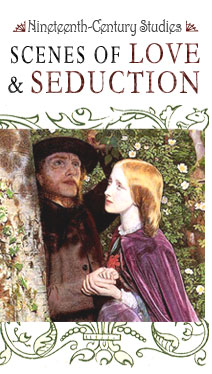Nina Baym, from the "Introduction" to The Hidden Hand, by E.D.E.N. Southworth (1997)
Transcribed from pages xi-xiii of the 1997 Oxford University Press publication of E.D.E.N. Southworth's The Hidden Hand.
Louisa May Alcott, for example, whose work clearly registers Southworth's influence, depicts the literary career of Jo March in Little Women (1869) as getting off to a bad start on account of Southworth. Eager to publish, Jo begins a career by writing stories in imitation of the extremely popular Mrs S. L. A. N. G. Northbury (an allusion so obvious that nobody at the time could have missed it). In chapter 27, 'Literary Lessons,' Jo first encounters what Alcott calls Mrs. Northbury's 'trash' at a typically high-brow Boston lecture on the Egyptian pyramids, where she is sitting next to a 'studious-looking' youth reading an illustrated paper called The Weekly Volcano. Glancing at the illustration, Jo wonders 'what unfortuitous concatenation of circumstances needed the melodramatic illustration of an Indian in full war costume, tumbling over a precipice with a wolf at his throat, while two infuriated young gentlemen, with unnaturally small feet and big eyes, were stabbing each other close by, and a disheveled female was flying away in the background, with her mouth wide open.' The story turns out to be one of 'that class of light literature in which the passions have a holiday, and when the author's invention fails, a grand catastrophe clears the stage of one-half the dramatis personae, leaving the other half to exult over their downfall.'
Hearing from her studious-looking neighbour that the story is first-rate and that its author makes excellent money, Jo takes Mrs Northbury as her 'model' (ch. 34) and submits her own sensational efforts to The Weekly Volcano. 'Eager to find material,' the inexperienced author reads up on incidents of 'folly, sin, and misery,' thereby unconsciously 'beginning to desecrate some of the womanliest attributes of a woman's character,' feeding 'heart and fancy on dangerous and unsubstantial food,' and 'fast brushing the innocent bloom from her nature by a premature acquaintance with the darker side of life, which comes soon enough to all of us.' Fortunately for Jo, at least in the narrator's view, she is rescued from the nefarious influence of Mrs Northbury by the exhortations of the middle-aged German intellectual who will become her husband, Professor Bhaer, who advises her 'to study simple, true, and lovely characters, wherever she found them.'
Since Alcott herself had begun her career by publishing numerous potboiling melodramas under an assumed name (melodramas whose authorship remained unknown for many decades), she was obviously both alluding to and disavowing her own past through this critique. But unless one has read The Hidden Hand, one cannot realize that Jo March herself, arguably the nation's most famous tomboy heroine—Jo characterizes herself at the novel's outset by bitterly complaining over not being a boy—derives directly from Capitola, heroine of The Hidden Hand. This heroine, who enters the novel in boy's clothing and romps through it disrupting numerous expectations for womanly behaviour, is not only the first of a long line of tomboy heroines in American fiction, but one of only a few in the nineteenth century who never relinquishes nor apologizes for her tomboy character. She is also the progenitor of the many female action heroines, especially female detectives, who populate fiction today. These are the women characters whose energy, curiosity, sass, street savvy, and above all compelling sense of justice lead to adventures where they uncover secrets, right wrongs, and defend true morality over social custom. The basic message of these popular novels now, like the message of The Hidden Hand then, is that the essence of true womanhood lies within and can never be compromised by merely unconventional behaviour.
The Hidden Hand takes place mostly in rural Virginia, after the urban street waif Capitola, who was mysteriously brought to New York City from Virginia as an infant by a domestic trying to save her life, returns there as ward of Ira Warfield, 'Old Hurricane.' Not content with life as the plantation belle Old Hurricane wants her to be, Capitola ranges around the countryside on horseback looking for adventures, a self-styled female version of Don Quixote. Even as she battles with the notorious bandit Black Donald and his gang, fights a mock duel, and rescues an imprisoned maiden, she is herself the target of much covert villainy, because although she does not know it she is heiress to a vast fortune misappropriated by the villainous Le Noirs, father and son, who live on the adjoining plantation. Like most of Southworth's novels, The Hidden Hand contains numerous initially unconnected plots and a large cast of apparently unrelated characters, all of which mesh in the denouement. Undoubtedly some of the fun in reading a Southworth serialization involved waiting to see how the author would weave all these seemingly loose strands into a single pattern.
Unlike the far more genteel Jo March, whose womanly character is apparently besmirched merely by reading about crime and passion, Capitola has genuine 'premature acquaintance' with the darker side of life. We meet her as a street child trying to survive in New York City by masquerading as a boy. Also unlike Jo, Capitola's experiences and behaviour never even remotely begin to 'desecrate' her womanly character. Her reason for cross-dressing is, precisely, to preserve that character. 'While all the ragged boys I knew could get little jobs to earn bread, I, because I was a girl, was not allowed to carry a gentleman's parcel, or black his boots, or shovel the snow off a shopkeeper's pavement, or put in coal, or do anything that I could do just as well as they. And so, because I was a girl, there seemed to be nothing but starvation or beggary before me,' she explains. 'I felt bitter,' she goes on, 'against fate for not making me a boy!' Then, 'all of a sudden, a bright thought struck me: and I made up my mind to be a boy!' Disguised as a boy, Capitola can support herself by doing anything an 'honest lad' can do—the phrase making clear that no honest work was available to a 'lass'. 'The only thing that made me feel sorry, was to see what a fool I had been, not to turn to a boy before'.
Since Capitola's masquerade would admittedly be difficult if not impossible to maintain as she matured, and since Southworth does not want to cut her story's ties to reality entirely, she rescues her heroine from life as a boy at the start of the novel. Except for her tendency to express herself in slang, and her continuing relation with her best friend, a young sailor named Herbert Greyson, Capitola loses touch with her street associations. But the issues of womanliness and gender introduced by this opening segment of the novel continue to frame the fiction. 'Come, come, my little man!—my good little woman, I mean,' says Hurricane to Capitola as she explains why she chose to put on boy's clothing; and late in the novel he is still calling her 'a New York newsboy,' complaining that she'll never be a woman, and addressing her alternately as sirrah and Miss.
Certainly The Hidden Hand could not have been the wildly popular work it was if it had been merely serious and sober; at its core, this is an action comedy with a female lead. Yet readers in the United States before the Civil War expected a good moral as part of the package, and Southworth has several good morals to offer concerning women, men, and society. Throughout the novel Capitola continues to reject most rules of female decorum as humbug at best, perniciously hypocritical at worst. The author regularly attributes Capitola's attractiveness as a character, as well as her success within the plot where other female characters fail, to her recognition of the dangers of false ideologies of true womanhood. Although Southworth thereby attacks what seem to her destructively influential ideologies of the feminine, she also powerfully affirms her belief in an undeniable, real womanliness, and this is crucial to Capitola's appeal. From the start we realize that Capitola has put on boy's clothes to preserve her virginity; the point is made that conventional stereotypes, far from preserving female virtue, are inimical to it. Southworth's criticism of female stereotypes assumes that they injure women not only as human beings in general but as women in particular; hence, whatever women have to offer as women is lost not only to them but to society as well.








